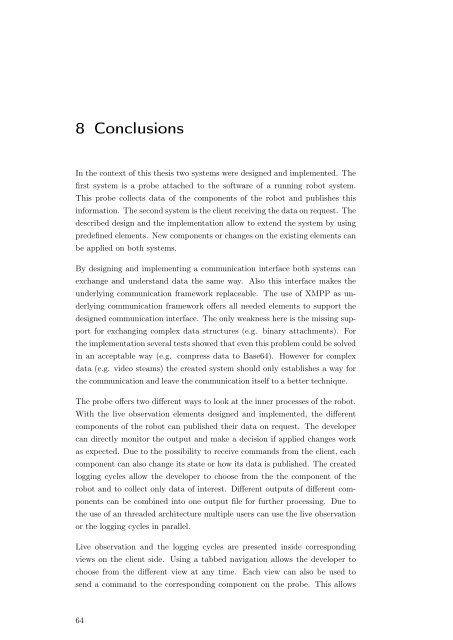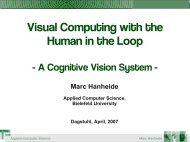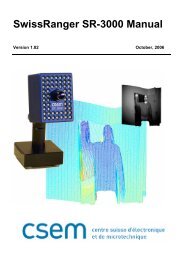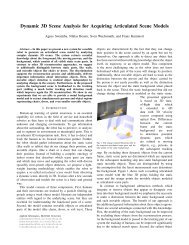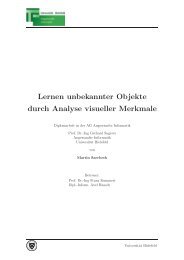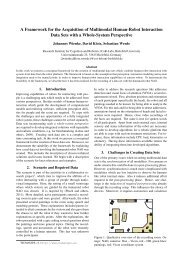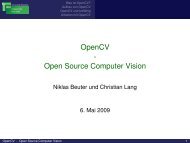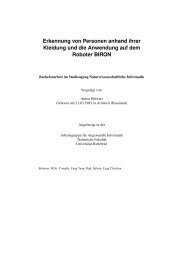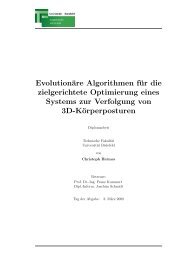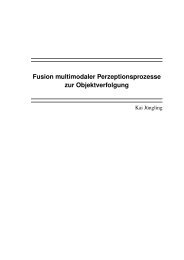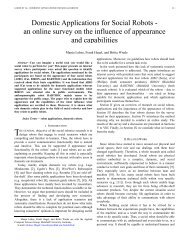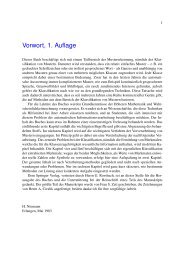System Introspection for System Analysis on Mobile Devices
System Introspection for System Analysis on Mobile Devices
System Introspection for System Analysis on Mobile Devices
You also want an ePaper? Increase the reach of your titles
YUMPU automatically turns print PDFs into web optimized ePapers that Google loves.
8 C<strong>on</strong>clusi<strong>on</strong>sIn the c<strong>on</strong>text of this thesis two systems were designed and implemented. Thefirst system is a probe attached to the software of a running robot system.This probe collects data of the comp<strong>on</strong>ents of the robot and publishes thisin<str<strong>on</strong>g>for</str<strong>on</strong>g>mati<strong>on</strong>. The sec<strong>on</strong>d system is the client receiving the data <strong>on</strong> request. Thedescribed design and the implementati<strong>on</strong> allow to extend the system by usingpredefined elements. New comp<strong>on</strong>ents or changes <strong>on</strong> the existing elements canbe applied <strong>on</strong> both systems.By designing and implementing a communicati<strong>on</strong> interface both systems canexchange and understand data the same way. Also this interface makes theunderlying communicati<strong>on</strong> framework replaceable. The use of XMPP as underlyingcommunicati<strong>on</strong> framework offers all needed elements to support thedesigned communicati<strong>on</strong> interface. The <strong>on</strong>ly weakness here is the missing support<str<strong>on</strong>g>for</str<strong>on</strong>g> exchanging complex data structures (e.g. binary attachments). Forthe implementati<strong>on</strong> several tests showed that even this problem could be solvedin an acceptable way (e.g. compress data to Base64). However <str<strong>on</strong>g>for</str<strong>on</strong>g> complexdata (e.g. video steams) the created system should <strong>on</strong>ly establishes a way <str<strong>on</strong>g>for</str<strong>on</strong>g>the communicati<strong>on</strong> and leave the communicati<strong>on</strong> itself to a better technique.The probe offers two different ways to look at the inner processes of the robot.With the live observati<strong>on</strong> elements designed and implemented, the differentcomp<strong>on</strong>ents of the robot can published their data <strong>on</strong> request. The developercan directly m<strong>on</strong>itor the output and make a decisi<strong>on</strong> if applied changes workas expected. Due to the possibility to receive commands from the client, eachcomp<strong>on</strong>ent can also change its state or how its data is published. The createdlogging cycles allow the developer to choose from the the comp<strong>on</strong>ent of therobot and to collect <strong>on</strong>ly data of interest. Different outputs of different comp<strong>on</strong>entscan be combined into <strong>on</strong>e output file <str<strong>on</strong>g>for</str<strong>on</strong>g> further processing. Due tothe use of an threaded architecture multiple users can use the live observati<strong>on</strong>or the logging cycles in parallel.Live observati<strong>on</strong> and the logging cycles are presented inside corresp<strong>on</strong>dingviews <strong>on</strong> the client side. Using a tabbed navigati<strong>on</strong> allows the developer tochoose from the different view at any time. Each view can also be used tosend a command to the corresp<strong>on</strong>ding comp<strong>on</strong>ent <strong>on</strong> the probe. This allows64


